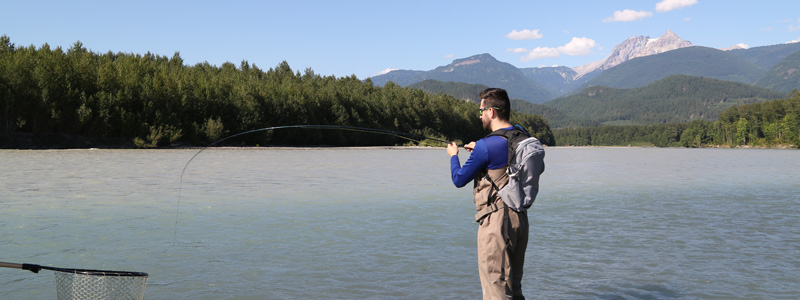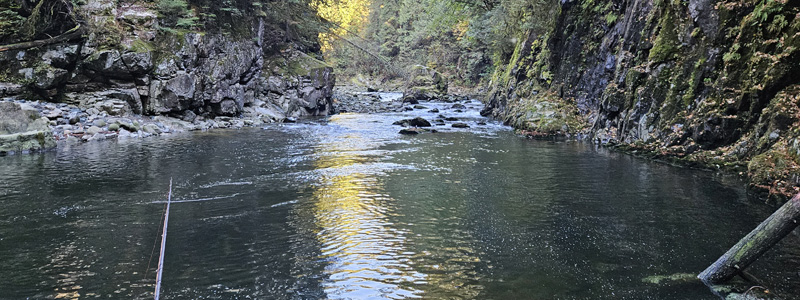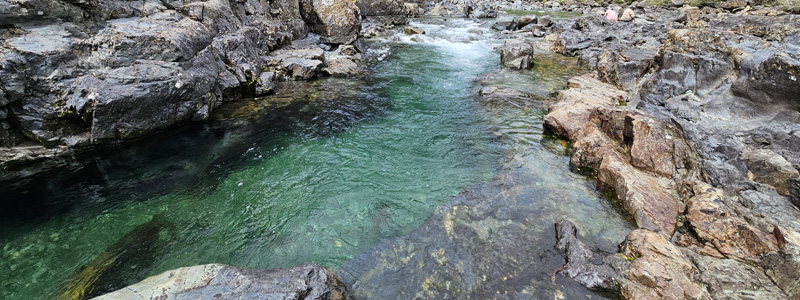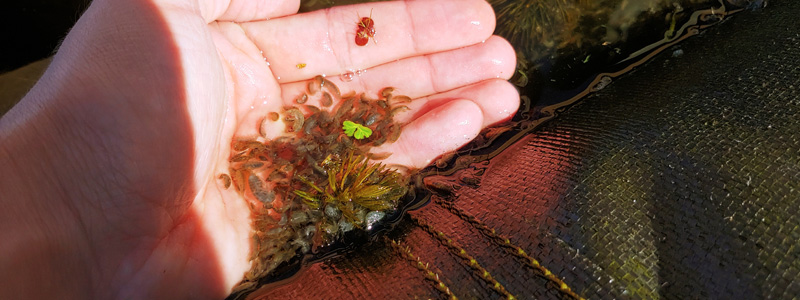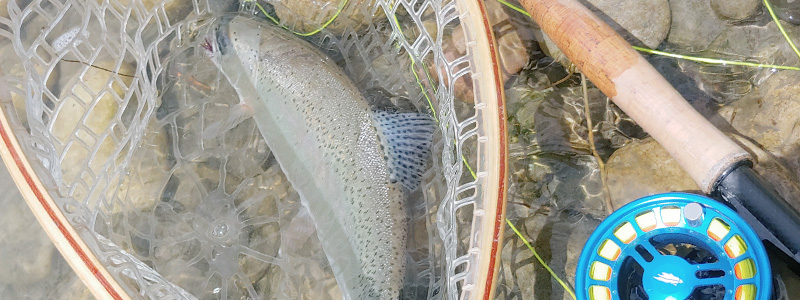Welcome to our beginners guide to fly fishing for trout! Whether you’re new to angling or looking to refine your skills, we’ve got you covered. In this comprehensive guide, we’ll walk you through everything you need to know to get started with fly fishing for trout. From selecting the right gear to mastering essential techniques, we’ll provide you with the knowledge and confidence to embark on your fly fishing journey.
Gear Selection
Let’s dive into the gear you’ll need to get started on your fly fishing journey for trout. The best general purpose fly fishing setup for trout (and many other species) is a 5 or 6 weight fly fishing combo with a medium-fast fly rod, fly reel (we recommend CNC machined fly reels as they are built with the least amount of impurities, and are the strongest) and weight-forward fly line for general purpose . For more information, check out our ultimate guide to fly fishing for beginners.
Essential Flies for Trout Fishing
Now, let’s talk about flies. As a beginner, you don’t need to go crazy and buy every fly in the shop. Start with a basic selection of dry flies, nymphs, and streamers. Some must-haves include:
- Parachute Adams
- Elk Hair Caddis
- Pheasant Tail Nymph
- Zebra Midge
- Squirmy worm
- Woolly Bugger
- water boatman
- leech fly
These flies will cover a wide range of situations and help you catch trout in various conditions.
Waders and Boots
While not absolutely necessary, waders and wading boots can greatly enhance your fly fishing experience. They allow you to navigate rivers and streams comfortably, giving you access to prime fishing spots. Breathable waders are a good choice for most conditions, and make sure to get boots with good traction to avoid slips on slippery rocks.
Accessories and Tools
Don’t forget about the little things that can make a big difference:
- A good pair of polarized sunglasses to help you spot fish
- Nippers for cutting line
- Forceps for removing hooks
- A net for landing fish safely
- Floatant for dry flies
- Split shot or swivel for added sinking weight
You might be wondering why split shots or swivels, and that’s a good question. Sometimes you need to get deeper faster, or if you’re fishing in streams or rivers with a faster current, if your line is not heavy enough, it will not get deep enough to reach the fish. To get past this problem, anglers commonly use a sinking tip line, or a small split shot weight (or a swivel) placed a couple of feet above your hook.
In certain situations this can make the difference between catching fish and catching nothing. This has led us to catching many fish, including brown trout which generally seem to prefer the bottom half of the waterbody. Another species that generally prefers to stay in 6-10ft is the walleye, another great species that can be caught on the fly (walleye are also quite tasty, and quite famous for their taste in Alberta).
How Do You Choose the Perfect Spot for Trout Fly Fishing?
Finding the right spot to cast your line is half the battle in fly fishing for trout. Let’s explore how to identify promising locations and understand trout behavior.
Understanding Trout Habitat
Trout are cold-water fish that thrive in oxygen-rich environments. They prefer water temperatures between 50-65°F (10-18°C). Look for streams, rivers, and lakes with clear, cool water and plenty of cover. Trout often hang out near:
- Undercut banks
- Fallen trees or logs
- Large rocks or boulders
- Deeper pools
- Seams where fast and slow water meet
Reading Water and Identifying Promising Locations
Learning to read water is a crucial skill in the beginner’s guide to fly fishing for trout. Pay attention to:
- Riffles: Shallow, fast-moving water where trout often feed
- Runs: Deeper, steadier currents where trout rest and ambush prey
- Pools: Deeper, slower areas where larger trout may lurk
- Eddies: Swirling water behind obstacles where trout conserve energy
Seasonal Considerations for Trout Fishing
Trout behavior changes with the seasons, so it’s important to adjust your approach accordingly:
- Spring: Look for trout in slower, deeper water as they recover from winter
- Summer: Focus on cooler, oxygen-rich areas like riffles and shaded spots
- Fall: Target areas where spawning trout congregate
- Winter: Fish deep, slow pools where trout conserve energy
What Are the Fundamental Casting Techniques for Fly Fishing?
Mastering the art of casting is essential for successful fly fishing. Let’s break down some basic techniques that every beginner should know.
Basic Overhead Cast
The overhead cast is the foundation of fly fishing. Here’s how to do it:
- Start with your rod tip low, line extended in front of you
- Lift the rod smoothly to the 10 o’clock position
- Pause briefly to let the line straighten behind you
- Bring the rod forward to the 2 o’clock position
- Stop the rod abruptly to let the line unfurl in front of you
Practice this motion until it feels smooth and natural. Remember, it’s more about finesse than power.
Roll Cast for Tight Spaces
The roll cast is perfect for situations where you have limited room behind you, like when fishing near bushes or trees:
- Start with your rod tip low, line on the water in front of you
- Slowly lift the rod to about 1 o’clock position
- Pause briefly, then smoothly accelerate the rod forward
- Stop the rod at the 10 o’clock position
This cast doesn’t require a back cast, making it ideal for tight spots where you may be surrounded by trees or other obstacles. PS: This cast is most effective and easiest to deal with when you use a floating fly line (as opposed to sinking) and a lightweight fly (as in, no split shot attached to the line).
False Casting to Improve Accuracy
False casting involves making multiple back and forward casts without letting the line touch the water. It’s useful for:
- Drying your fly
- Measuring distance to your target
- Improving accuracy
- slowly letting out more line which will cast further away
To false cast, simply repeat the overhead cast motion without letting the line land on the water. Having said that, don’t go for perfect casts, go for good enough. Remember, in order to catch fish, you line must actually be in the water (you don’t need to do 10 false casts before your line hits the water).
Mending Line for Better Presentation
Mending is a technique used to counteract the effects of current on your fly, and something quite important when fly fishing a stream or river as this will make your presentation look more natural:
- After your cast, lift your rod tip
- Move the rod upstream or downstream to reposition the line (generally you move it upstream, unless the current is slow enough to the point where your line almost stops moving downstream)
- Lower the rod tip to let the line settle
This helps achieve a more natural drift and increases your chances of a strike. PS: You may need to do this multiple times each cast.
How Do You Select the Right Flies for Trout?
Choosing the right fly can make the difference between a successful day on the water and going home empty-handed. Earlier, we mentioned some popular flies, but how did we choose those? Let’s explore how to make the best fly selections.
Matching the Hatch: Understanding Trout Food Sources
“Matching the hatch” means using flies that imitate the insects trout are currently feeding on. This requires observing what’s happening on and around the water. Look for:
- Insects flying around or on the water surface
- Empty insect shells floating downstream
- Insects under rocks, or swimming in the water column
Common trout food sources include mayflies, caddisflies, stoneflies, midges, water boatmen, and terrestrial insects like ants, beetles and grasshoppers.
Dry Flies vs. Wet Flies vs. Nymphs vs Streamers
Different types of flies imitate different stages of insect life:
- Dry Flies: These float on the water surface, imitating adult insects
- Wet Flies: These are fished below the surface, imitating emerging insects
- Nymphs: These sink to the bottom, imitating immature aquatic insects
- Streamers: These flies imitate larger prey such as leeches, crayfish, small fish (often called minnows)
As a beginner, it’s good to have a mix of all four in your fly box. The options we gave you earlier would be a good starting point.
Seasonal Fly Selection
Fly selection often changes with the seasons:
- Spring: Focus on nymphs and emergers as insects start to become active
- Summer: Use a variety of dry flies to match abundant insect hatches
- Fall: Terrestrial patterns like grasshoppers can be effective. Depending on where you live, this may be prime time for water boatmen (here in Alberta, water boatmen come in full force in fall, and flies imitating these can and will catch BIG trout)
- Winter: Small midges and nymphs are often the go-to choices
What Are the Best Strategies for Presenting Your Fly to Trout?
Now that you’ve selected the right fly, it’s crucial to present it in a way that entices trout to bite. Let’s explore some effective presentation techniques.
Drag-Free Drifts
A drag-free drift means your fly is moving at the same speed as the current, just like a natural insect would. This is especially important when fishing with dry flies. To achieve a drag-free drift:
- Cast upstream of your target
- Mend your line as needed to prevent drag
- Keep your rod tip high and follow the fly downstream
- Using a loop knot on the hook can give it some wiggle room to move around more naturally
Remember, any unnatural movement of your fly can spook wary trout.
Upstream vs. Downstream Presentations
Both upstream and downstream presentations have their place in fly fishing:
- Upstream: This is often preferred as it allows for a more natural drift. Cast above the fish and let your fly float down to them.
- Downstream: Useful in fast water or when fishing streamers. Cast downstream and across, then retrieve your fly against the current.
Nymphing Techniques
Nymphing is a highly effective method for catching trout, especially when there’s no visible surface activity. Some popular nymphing techniques include:
- Indicator Nymphing: Use a small float (indicator) to detect subtle strikes
- Euro Nymphing: A tight-line technique that uses heavy nymphs and no indicator
- Dry-Dropper: Suspend a nymph below a dry fly, which acts as both fly and indicator
Streamer Fishing Tactics
Streamers imitate larger prey like small fish or leeches. When fishing streamers:
- Cast across and slightly downstream
- Let the streamer sink for a moment
- Retrieve with short, quick strips to imitate a fleeing baitfish
- Vary your retrieve speed and pattern to find what works
Streamer fishing can be particularly effective for larger trout, especially in low light conditions or stained water.
How Can You Improve Your Chances of Hooking and Landing Trout?
Getting a trout to bite is only half the battle. Now, let’s focus on how to successfully hook and land your catch.
Proper Hook-Setting Techniques
The key to setting the hook effectively is to be quick but not too forceful. Here’s how:
- For dry flies: When you see the fish take your fly, quickly lift your rod tip
- For nymphs: When your indicator moves or you feel a tug, quickly lift your rod tip
- For streamers: When you feel resistance, give a quick, firm strip-set
Remember, trout have soft mouths, so you don’t need to set the hook as hard as you might with other fish species.
Playing and Fighting Trout Effectively
Once you’ve hooked a trout, the goal is to tire it out without breaking your line or losing the fish. Here are some tips:
- Keep your rod tip up to absorb shock
- Keep the line TIGHT, especially if you fish with a barbless hook (which we highly encourage as it does much less damage to the fish, and it’s much easier to unhook afterwards). If you have any slack, the trout can easily spit out the hook and get away
- Use side pressure to steer the fish away from obstacles
- Let the fish run if it wants to, controlling it with your drag
- Don’t rush – take your time and wear the fish down
Landing and Handling Fish Safely
When the trout is tired and ready to be landed:
- Use a net if possible – it’s easier on both you and the fish
- Wet your hands before touching the trout to protect its slime coat
- Support the fish’s body and avoid squeezing it
- Keep the fish in the water as much as possible
- Do not put your hands in its gills
Catch and Release Best Practices
If you’re practicing catch and release (which is great for conservation), follow these guidelines:
- Use barbless hooks for easier removal
- Minimize the time the fish is out of water
- Revive the fish in the current before releasing it
- Let the fish swim away on its own when it’s ready
What Are Some Common Mistakes Beginners Make When Fly Fishing for Trout?
As with any new skill, there are some common pitfalls that beginners often encounter when learning to fly fish for trout. Being aware of these can help you avoid them and accelerate your learning curve.
Overlooking Stealth and Presentation
One of the biggest mistakes beginners make is being too obvious in their approach. Trout have excellent vision and are easily spooked. To avoid this:
- Wear muted colors that blend with the surroundings
- Approach the water slowly and quietly
- Avoid casting your shadow over the water you’re fishing
- Focus on achieving a natural drift with your fly
Ignoring Local Regulations and Etiquette
Every fishing location has its own set of rules and unwritten codes of conduct. Failing to respect these can lead to fines or conflicts with other anglers. Always:
- Check local fishing regulations before you go
- Obtain necessary licenses and permits
- Practice proper catch and release techniques if required
- Respect other anglers’ space on the water
Misreading Water Conditions
Understanding how water conditions affect trout behavior is crucial. Common mistakes include:
- Fishing during the heat of the day in summer when water temperatures are too high
- Overlooking subtle changes in water levels or clarity
- Failing to adjust tactics based on water conditions
Overcomplicating Fly Selection
While having a variety of flies is good, beginners often get overwhelmed trying to match every possible insect. Instead:
- Start with a basic selection of proven patterns
- Learn to fish these flies effectively before expanding your collection
- Focus on presentation over having the perfect fly
- Switch it up every once in a while. If you’re fishing the same fly for an hour and you get nothing, try something new
Remember, a well-presented “wrong” fly often outperforms a poorly presented “right” fly.
How Can You Practice and Improve Your Fly Fishing Skills?
Becoming proficient at fly fishing for trout takes time and practice. Here are some ways you can hone your skills both on and off the water.
Casting Practice Exercises
Regular casting practice is essential for improving your accuracy and distance. Try these exercises:
- Hula Hoop Casting: Set up hula hoops at various distances and practice landing your fly in them
- Lawn Casting: Use your lawn to practice different casting techniques without the pressure of being on the water
- Target Practice: Set up small targets (like paper plates) and work on your accuracy
Knot Tying Drills
Knowing how to tie strong, reliable knots is crucial in fly fishing. Practice tying these essential knots:
- Improved Clinch Knot
- Surgeon’s Knot
- Double Surgeon’s Loop
- Perfection Loop
Try timing yourself and practicing until you can tie these knots quickly and consistently.
Fly Tying Basics
While not necessary, learning to tie your own flies can be a rewarding aspect of fly fishing. It gives you a deeper understanding of insect imitation and can save you money in the long run. Start with simple patterns like:
- Woolly Bugger
- Elk Hair Caddis
- Pheasant Tail Nymph
Many fly shops offer beginner fly tying classes, which can be a great way to get started.
Joining Local Fly Fishing Clubs or Classes
Connecting with other fly fishers is one of the best ways to improve your skills. Consider:
- Joining a local fly fishing club
- Attending fly fishing shows or expos
- Taking classes or workshops from experienced anglers
- Hiring a guide for personalized instruction
Remember, the key to improving your fly fishing skills is consistent practice and a willingness to learn. Don’t be discouraged if you don’t catch fish every time out – every day on the water is an opportunity to learn and improve.
Conclusion
Armed with this beginners guide to fly fishing for trout, you’re now ready to embark on your angling adventure. Remember, patience and practice are key to mastering the art of fly fishing. As you gain experience, you’ll develop your own techniques and preferences. Don’t be afraid to experiment and learn from fellow anglers. Now, grab your gear, head to the water, and enjoy the rewarding pursuit of fly fishing for trout!


